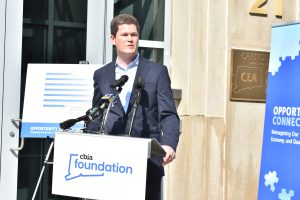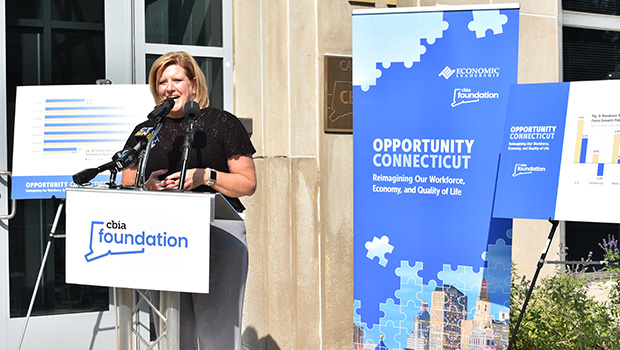“As educators, we’re often overlooked in discussions about economic growth, but we are in fact a foundational aspect of economic opportunity, and so I’m very proud—and our teachers are very proud—that we are a part of this forward-looking vision,” CEA President Kate Dias said at a news conference last week announcing a long-term roadmap for growing the state’s economy.
The plan—Opportunity Connecticut: Reimagining Our Workforce, Economy, and Quality of Life—looks to boost the state’s economic competitiveness, expand career pathways, retain and attract investment and talent, and foster innovation. It was developed after extensive research and dozens of forums across the state hosted by the CBIA Foundation—a diverse group of stakeholders representing education, business and industry, the nonprofit sector, and community leaders.
“We wanted to ensure that everyone had not only a seat at the table but also a stake in its success in the years to come,” said CBIA President and CEO Chris DiPentima, adding, “Connecticut’s economic opportunities are limitless. Our goal with the foundation and this plan is to chart a course for sustained economic growth—growth that drives not only predictability but greater opportunity for all residents.”

Dalio Education’s Andrew Ferguson emphasizes the role of public schools and teachers in a state’s economic growth.
“It’s notable that the state’s largest business association and the state’s largest association of public school educators are at the same table,” Dalio Education Co-CEO Andrew Ferguson noted at the news conference. “This work—especially around education and workforce development—does not become real if we all don’t listen to teachers and understand their needs from the classroom perspective. It requires that we build a public education system that works not just for some or many, but for all. It requires that we build upon what’s working and acknowledge what’s not. It also does not become real if we don’t listen to employers, and it certainly doesn’t become real if we don’t listen and respond to the needs of employees and young adults who are becoming employees.”
“When we talk about what our state needs and what our students need, educators get excited,” said Dias, “because we play a key role in developing Connecticut’s workforce and economic future. We’re seizing this opportunity to shape a frontline economic vision that’s innovative and strategic. The world of work is wide and complex, and we need to be exploring that with our students and developing mechanisms in our school systems that support that concept. It would go a long way toward meeting our students’ needs and, in particular, addressing some of the problems around disconnected youth. To lead Connecticut into the future, we must provide all students with a first-class education system that ensures they learn the skills necessary to be tomorrow’s leaders. CEA is excited to partner with the CBIA Foundation to build a bridge between education and opportunity for all students.”
The Opportunity Connecticut economic action plan focuses on three strategic pillars to drive sustained economic growth and create more opportunities for all Connecticut residents:
- Business Climate
- Workforce and Education
- Quality of Life
It outlines goals and key recommendations for each pillar that Connecticut’s public and private sectors can endorse, promote, and implement through partnership and collaboration.
Speakers at last week’s news conference also included Shawn Coyne, General Dynamics Electric Boat vice president of human resources, and Carol Quinn Toomey, managing director of Accenture’s Hartford office.







